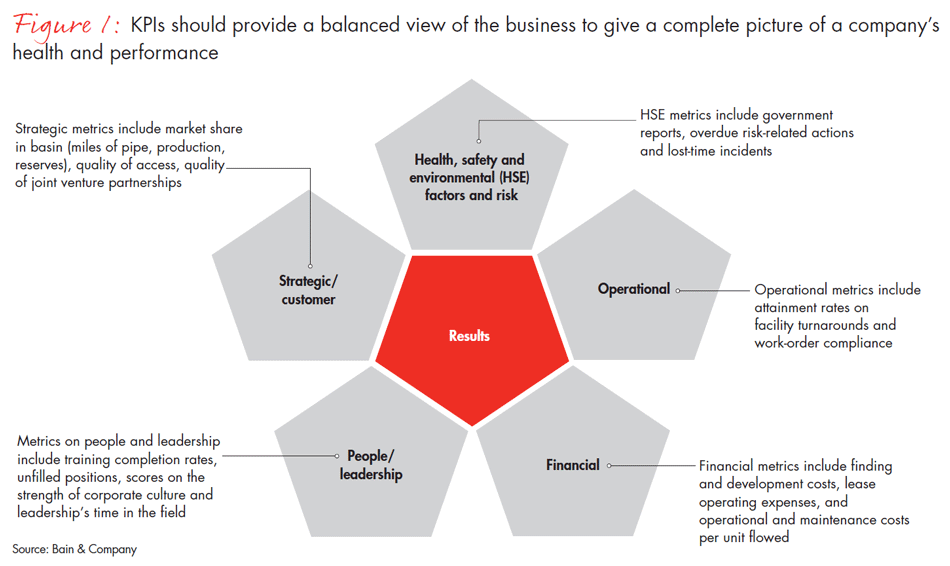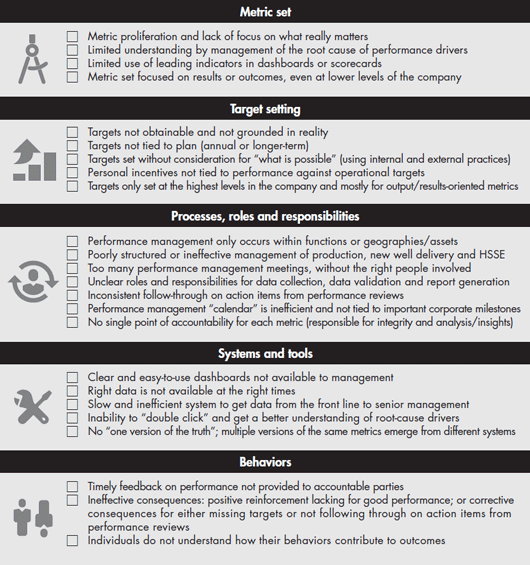Etude

As part of Bain’s ongoing series on operational excellence in the oil and gas industry, this brief highlights our current thinking on performance management. Other briefs in this series have examined integrated planning, operational excellence management systems and the imperative for operational excellence.
In the world of elite sports, playing for a high-performing team can be an uncomfortable experience at times. With expectations set high, each missed basket, each missed open goal or every dropped pass brings groans from other players and spectators alike. Even when you are ahead of the pack, missed opportunities are disappointing.
Leading oil and gas companies are not FC Barcelona or the New York Yankees, but our experience working with many of them suggests they view their own performance in much the same way. We see well-respected, world-class organizations where the sharp edge of performance is occasionally lacking. This typically means the organization is not meeting its own performance goals—which often results from inadequately managing performance. Sometimes this occurs because senior executives have not defined success clearly, or they have focused excessively on identifying benchmarks while avoiding more critical discussions on how they should use metrics to make better decisions about how they run the business.
To raise their game, oil and gas executives may need to revisit the way they manage performance. Leading players take an approach that goes well beyond benchmarks to develop the right forums and decision-making processes that will turn metrics and insights into the right discussions, decisions and actions. They set up their reporting systems to inform strategic and operational decisions. They integrate performance management with other cross-functional processes that guide the business, such as risk management and capability development. Connecting performance to incentives ensures accountability. Finally, they find ways to make their programs stick, including linking performance management with their annual planning cycles and developing dashboards that allow managers to keep an eye on metrics—which, while not the whole solution, continue to inform their daily and longer-term decisions.
John McCreery, a partner in Bain's Oil and Gas practice, explains how companies can adapt to industry shifts.
Measure to improve decisions
Better performance management begins with a more focused approach to measurement and reporting systems. Oil and gas companies are flooded with data, and the flow increases daily as more sensors come online and teams devise more ways to collect and analyze data. This rising tide of data brings the risk of measuring for the sake of measurement. Executives need to focus their analytic resources and reporting systems on the information that matters most. They can start with three straightforward and interconnected questions:
- How do we measure our performance?
- What decisions do we need to get right to succeed?
- How can metrics help improve our decisions?
Answering the first question helps clarify the strategic goals of the business: What do we do, and how do we know when we are winning? Discussions about measuring performance lead to discussions about improving performance, and so this discussion is as much about understanding the requirements of success as it is about measuring success.
Second, assessing the decision-making process is the start of understanding how an organization evaluates what it knows and how it acts on that information to achieve its goals and create value. This process should explore the fact base underlying decisions as well as the accountability of those making them. Leading organizations assign clear decision rights, partly to ensure accountability but also to streamline the decision-making process. At Bain & Company, we believe good decisions stem from four variables: an organization’s ability to make the right decision, to make it quickly, to follow up and execute, and to make the required effort to run the process.
The third question asks companies to decide which metrics are the most important to track and monitor. Good decisions require accurate and pertinent data that ties closely to the organization’s strategic priorities. Key performance indicators (KPIs) should give a balanced view of the business, covering the most important categories that indicate the health and performance of the business (see Figure 1). In the oil and gas industry, many standard metrics for exploration, development and production already exist, so companies do not need to reinvent the wheel.

Metrics are a means to an end: While they provide input for making well-informed decisions, they are not the determinants of policy. They are like gauges on the dashboard of a car—vital to help guide the journey, but incapable of telling the vehicle where it should go.
The trouble with benchmarks
Benchmarks are essential for making decisions about resource allocation, but they can be misused or misleading. Too many organizations base their performance management programs on a somewhat blind application of benchmarking, often as part of their aspiration to reach the top quartile among their industry peers. Benchmarks can add tremendous value where they measure quality or conformance to a standard that does not vary across basins. However, oil and gas is a diverse global industry, where vast differences in geology, operating conditions and organizational structures can make apples-to-apples comparisons difficult. Head counts, for example, can differ widely between companies that rely more on outsourced contractors and those that keep those capabilities in-house.
Because of differences like these, the real value of benchmarks in this industry lies in enabling organizations to identify the areas where they should invest to improve their operations and differentiate themselves, rather than as indicators of performance compared with competitors. The key to improving performance is not just about comparisons with other companies, but developing an action-oriented approach that links the insights gained from metrics to good decision making and accountability.
High-level cost benchmarks on corporate support services, such as finance and human resources, can help companies keep costs down, primarily by regarding them as indicators of best practice across the industry rather than as absolute numbers. In safety, where there is no room for variance, benchmarks can help organizations recognize gaps in their own performance vs. world-class standards.
Some oil and gas executives have told us that benchmarking at a high level across a diverse range of assets is somewhat useless and, in some cases, dangerously misleading. Companies can try to correct for differences but will have to spend much effort understanding the unique factors associated with individual assets. Worse still, some companies place excessive confidence on benchmarks as a “magic bullet” to solve performance gaps. The farther away from the front line one gets, the more distant these expectations seem to be from reality. An obsessive focus on benchmarks can have negative consequences: Some executives now look back at the benchmarking and cost-reduction efforts in the UK’s North Sea in the late 1990s as programs that led to reductions in maintenance and other corner-cutting measures. The North Sea is still living with this legacy as operators struggle to achieve targeted reliability and uptimes.
Partly in reaction to this overreliance on benchmarks, some international oil companies and independents are beginning to show a broad lack of enthusiasm for operational benchmarks and a tendency to dismiss them as not at all helpful. Instead, they might look at benchmarks as flawed but providing still useful data points, which can inform dialogue and target setting. As one North American executive told us, “They are simply one lens on the discussion.”
Link performance to behavior
Even with the best metrics, companies can improve their performance only with the right systems and tools that link performance to the desired behaviors through incentives and the correct alignment with the operating model.
Most important, performance management and incentives need to be aligned to the operating model. For example, many upstream and midstream organizations have recently moved from an asset-based model to a functional matrix. Unfortunately, few have recognized the need to realign performance indicators and incentives to the new set of accountabilities. Functions now play a key role in driving day-to-day operations, with asset leaders still accountable and measured on bottom-line performance.
That is only one example of how the misalignment between performance management and accountabilities can generate the wrong behaviors. Tying compensation to performance is one of the most effective ways to ensure alignment. As performance management systems are put in place, managers can redefine or reaffirm roles, deciding who is accountable for performance across functions and regions. Performance metrics should be one source of information for periodic reviews and planning discussions, and they are the key to designing well-aligned incentive systems.
Decision making is a key driver of performance, and executives can assess their skills with a few questions:
- How quickly can we make decisions?
- How often do we make wrong decisions?
- How well do we implement the outcome of a decision?
- How painful is the decision-making process?
A performance management system must do more than provide the right information in the right decision-making forums. It must also have an incentive scheme that fosters the correct behaviors and enables effective decision making (see the diagnostic checklist below). (For more about this, see the Bain Brief “What ‘good’ looks like: Creating an operational excellence management system.”)
Performance management is not easy to get right. Organizations have perfected the art of overengineering and overcomplicating the metrics in use. Some blindly follow benchmarks and lose sight of what good performance looks like. Others let their organizational structure create silos and excuses, frustrating CEOs and executive leaders who soon see routine decisions being escalated to their level.
In many ways, oil and gas is a simple business. Bain’s experience designing and implementing performance management systems for oil and gas companies suggests that much of the gain can come from focusing on a few vital metrics. These metrics can help produce consistent, high-quality forums for strategic discussions and decision making, which in turn lead to decisive action. Accountabilities for these actions must also be clear. Agreeing on the required behaviors—and the consequences of failing to follow them—is the glue that holds together successful performance management.
A diagnostic checklist can help executives assess the need for a performance management tune-up

For more on Bain’s Operational Excellence program, see these related Bain Briefs:
John McCreery is a Bain partner in Singapore. He leads the firm's Oil & Gas practice in the Asia-Pacific region.
